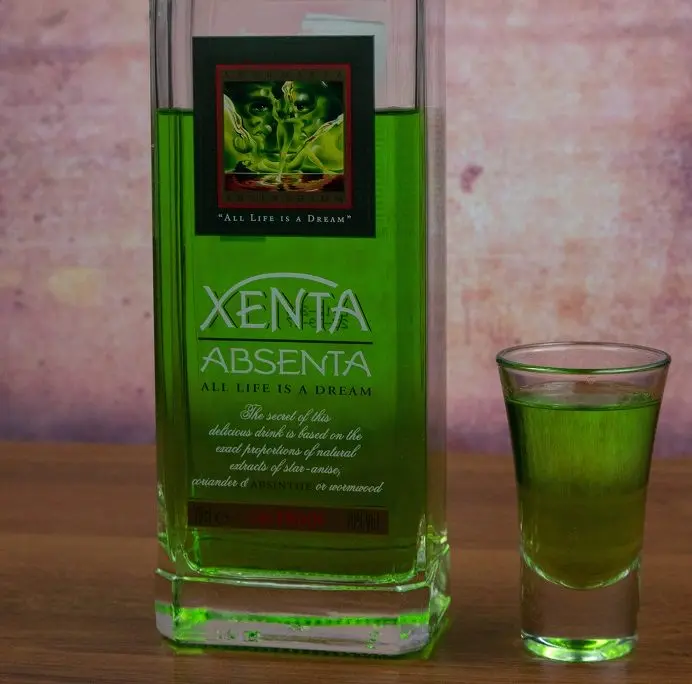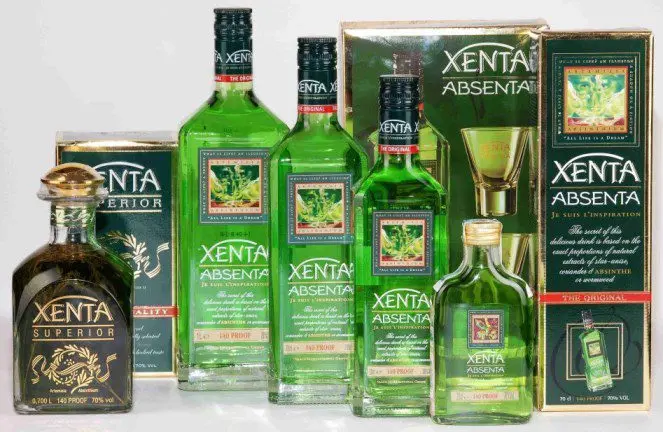Xenta is the first absinthe that the inhabitants of Russia and neighboring countries got acquainted with in the 90s. The taste of this tincture turned out to be exactly what is needed in order for the newcomer to taste it to have the most favorable impression of absinthe. The obligatory bitterness of the drink is balanced by a light licorice sweetness, and the rich aroma of wormwood with notes of anise and coriander awakens dreams of distant lands.
The advertising campaign of the tincture was carried out under the motto: “All life is a dream.” This inscription still adorns the labels of Xenta bottles.
Vasko International Group became the first importer of Xenta to the CIS countries. By her order, absinthe was produced in Spain, at one of the most famous factories – Destilerias Antonio Nadal, in the same place where they produce another brand of the famous wormwood tincture – Tunel.
Actually, at first, Xenta absinthe was a replica of Tunnel, designed specifically for the CIS countries. But already in the mid-90s, the Italian company Torino Distillati Srl acquired a license for the production of Xenta, and the recipe for the drink was somewhat improved.
Historical reference. The traditions of the production of various liqueurs and tinctures in Italy are more than one hundred years old. Piedmont, a mountainous land where peasants have grown grapes since ancient times, and the slopes of the Alps are covered with fragrant herbs every spring, is famous not only for ordinary wines, but also for fragrant vermouth, one of the best in Europe. Back in the XNUMXth century, local winemakers borrowed a recipe for a stronger liquor, absinthe, from neighboring Switzerland. In Piedmont, this tincture turned out to be no worse than Swiss, and rather cold winters contributed to its popularity.
In 1906, in the vicinity of the town of Moncalieri, not far from the capital of Piedmont – Turin, a new distillery was built, designed for the production of vermouth and other tinctures. Its owners, merchants from the old Piedmontese family Fratelli Ferrero di Ricardo, found an almost ideal place for such an enterprise: the large industrial city of Turin with its infrastructure was very close, and due to the proximity of the Alpine valleys, the transportation of raw materials was very cheap.
The tiny factory made excellent vermouth and absinthe, but the volume of production was too small. In the 60s of the XX century, due to the crisis that broke out in Italy, Ferrero di Ricardo was forced to sell his company to the Canadian corporation Seagram. She owned a huge number of distilleries around the world.
In the 90s, the new head of the corporation, Edgar Bronfman, began to invest heavily in the media and the film industry, gradually getting rid of non-core assets. The Italian branch of the company was threatened with closure. In 1992, its technical director, a native of Piedmont, Carlo Vergnano, bought the plant in Moncalieri and founded Torino Distillati.

Signor Vergnano appreciated all the advantages of entering the international market. He pays special attention to partners from Russia and the CIS countries, where genuine, high-quality Italian tinctures and liqueurs are in great demand. Most of the Xenta absinthe currently imported into Russia is produced by Torino Distillati.
Italian absinthe is richer than Spanish: if the Spanish variety of Xenta contains 10 mg of thujone per liter, then the Italian one contains 35 mg. This concentration allows you to fully experience the taste and aroma of the drink.
Wormwood for tincture is specially grown in ecologically clean alpine meadows, at an altitude of 2000 m above sea level. Italian winemakers use only the young tops of flowering plants: this is the most fragrant and least bitter part of the bush.
The quality of finished absinthe is checked in the same way as a hundred years ago. Experienced tasters collect some green tincture from a vat into a long transparent tube, evaluate the color of the liquid, then the aroma, and only after that they taste it. If the drink meets the standard, a corresponding mark is made with chalk on a board fixed above the vat.
Carlo Vergnano and his wife Piera strictly monitor the observance of technology. It is already known that when the owner of the company retires, he will hand over the reins of government to his daughter Rita. So fans of “Xenta” can be sure: in the next few decades, the quality of their favorite drink will not change.
Types of absinthe Xentha

Torino Distillati produces three types of Xenta absinthe:
- Xenta is a translucent grass-colored absinthe with a wormwood-anise scent. On the palate, the bitterness of young wormwood is harmoniously combined with the delicate sweetness of licorice and the taste of star anise;
- Xenta Superior is a dark green absinthe with a slightly tart wormwood-honey aroma, in which anise note is barely discernible. Taste – rich herbal;
- Xenta Distilled is a colorless, transparent absinthe from which the chlorophyll has been removed by distillation. The drink smells of anise and spices. Taste – rich anise with warm tones of coriander in the aftertaste.









